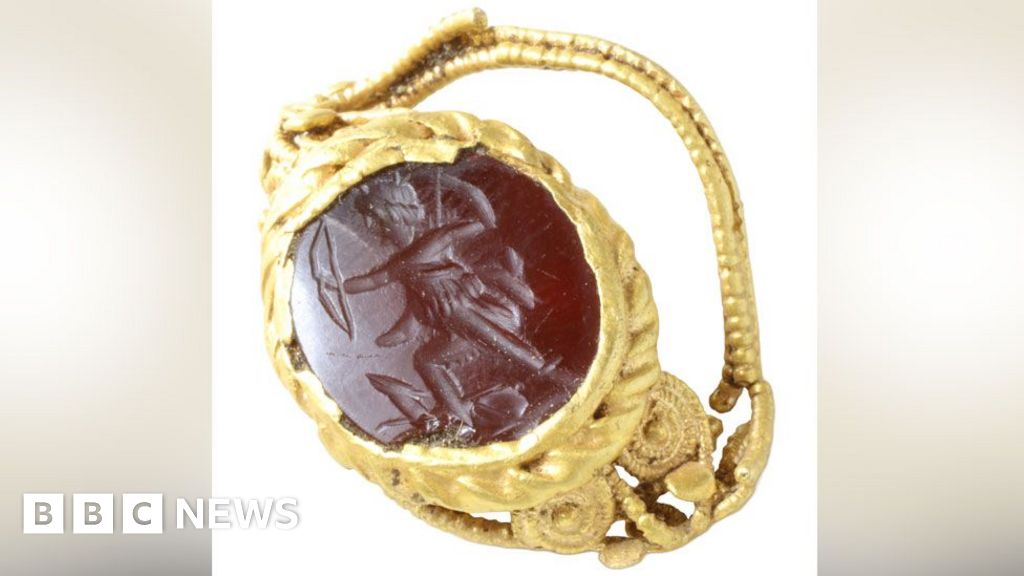On the fifth day of Christmas: Norfolk’s five gold rings

 Andrew Williams/Norfolk County Council
Andrew Williams/Norfolk County CouncilArchaeologist Helen Geake works in Norfolk – the treasure finds capital of the UK – and often thinks of the Twelve Days of Christmas carol in her work.
There is one particular verse that stands out: “On the fifth day of Christmas, my true love gave to me, five gold rings.”
“That’s me,” says Dr Geake who works as the county’s finds liaison officer. “I’m always finding gold rings in my work.”

She assesses objects discovered in the county by metal detectorists, in her role as part of a team that recommends whether the objects should be declared treasure by a coroner.
“Gold rings are one of the things that get lost more than most, pretty much everyone’s got a ring,” says Dr Geake.
“And they’re easy to lose, you take them off to wash and dry your hands, your fingers get fatter and thinner.”
Dr Geake has chosen five rings that have crossed her desk in 2024, each one revealing more about the people who lived in the county in centuries past.
1. A Roman ring depicting the goddess Diana
 Andrew Williams/Norfolk County Council
Andrew Williams/Norfolk County Council“It’s such a tiny, tiny thing and yet the design is so clear,” says Dr Geake about her first choice.
The find, in the village of Sedgeford, near Hunstanton, is set with a dark red gemstone.
It measures 18.2mm (0.7in), yet its depiction of the goddess Diana is packed with detail.
Dr Geake says: “She has her bow in one hand, the other is reaching for an arrow and there is even a little dog with its snouty nose and paw lifted.
“It is the tiniest bit of Roman art and there’s not an awful lot that has survived that isn’t sculpture.”
The highly decorated ring has similarities to a pendant found in the 4th Century Thetford Treasure hoard, and may even have come from the same workshop.
2. A Roman ‘chunk of gold’
 Andrew Williams/Norfolk County Council
Andrew Williams/Norfolk County CouncilHer next choice is also Roman but is “just a great chunk of gold”.
Dr Greake says: “It makes a nice counterpart to the other one and shows the variety of jewellery in the Roman world.
“It’s really chunky and feels completely different, with a slightly rough look as if it was hammered into shape.”
Discovered near King’s Lynn, it was made between the 1st and 4th Centuries.
And weighing 7.81g (0.3oz), “you could make five gold rings out of this one alone”, she adds.
It has been disclaimed – meaning it will be returned to its finder and the owner of the land it was found on – because museums lack the resources and spaces to claim every find.
Dr Geake says: “But it’s marvellous we know about it – and it has been added to the Portable Antiquities Scheme database.”
3. A Stuart-era mourning ring
 Andrew Williams/Norfolk County Council
Andrew Williams/Norfolk County CouncilMoving to the 17th Century and a ring found near Merton offers insight into the funeral rituals of people in the Stuart era.
Dr Geake says: “Mourning rings were made to remember the person who died and given out at funerals.
“Inside it is says, ‘SH died 5 May 93’ – we know this means 1693.”
 Andrew Williams/Norfolk County Council
Andrew Williams/Norfolk County CouncilPeople would leave money in their wills for rings to be created and distributed to family and friends in their memory.
“For example, the diarist John Evelyn distributed 60 rings to his daughter’s friends after her death – and the closer the friend, the better the ring,” says Dr Geake.
“But with this ring, we don’t know anything about them, which I find sad – is it a Samuel or a Sarah? Who was this person?”
4. A ‘mysterious’ Bronze Age ring
 Andrew Williams/Norfolk County Council
Andrew Williams/Norfolk County Council“There are loads and loads of these Bronze Age penannular rings in the database, more than 150 from the whole country, yet we just don’t know how they were used,” says Dr Geake.
Made between about 1300 BC to about 800 BC, it was discovered in north Norfolk and Norwich Castle Museum hopes to add the piece to its collection.
“Might it have been tied into hair? Would that work? Or perhaps it went around part of the ear like an ear cuff – but I’d be nervous it would fall out,” she says.
“It’s very perfect and I like this one a lot – many are split or broken in some way – they are lovely things, but mysterious.”
5. A medieval ring with the symbol of faithfulness
 Andrew Williams/Norfolk County Council
Andrew Williams/Norfolk County CouncilHer final choice is a 14th or 15th Century medieval ring unearthed at Hingham, which is covered in different forms of decoration, including two saints.
She thinks one of the saints might be St Barbara, in part because she in part because “she always carries a palm”.
According to legend, the saint was murdered by her father when she refused to give up Christianity and get married.
Dr Geake says: “The designs include shaking hands – the symbol of faithfulness -flowers, there are two saints carrying palms and it would have been very bright and colourful with traces of yellow, red, green and blue, while the engraving on the top would have been black and white.”
“It’s as if someone has chucked the kitchen sink at it in terms of every design possible.”
It only appears to be gold, but is in fact gilded over a silver base.
Its owner probably could not afford solid gold, but wanted a ring which had the appearance of the more costly material, says Dr Geake.
The item was disclaimed and returned to the finder and landowner.
 Andrews Williams/Norfolk County Council
Andrews Williams/Norfolk County CouncilWorld News || Latest News || U.S. News
Source link




